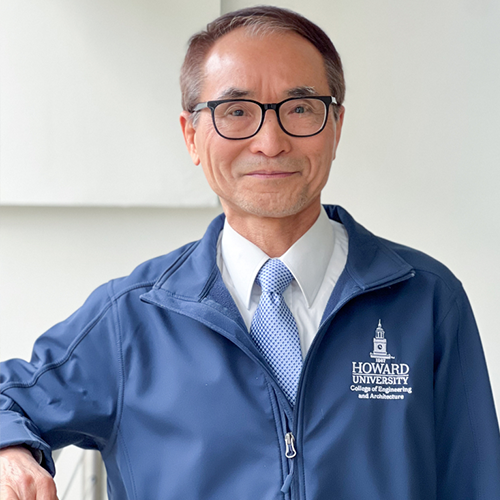Postdoctoral
Electrical Engineering
Texas A&M University
1990

Charles Kim, Ph.D., is a professor of electrical engineering and computer science in the College of Engineering and Architecture at Howard University. Kim began his career at Howard in 1999 and served as an assistant and associate professor before his appointment to professor in August 2013.
Kim has experience in applying information entropy and Bayesian inference as an intelligent and machine learning system to discrete time-series data for diagnostic detection, classification, and pattern discovery. He has applied machine reasoning to electronic component assessment for radiation impact and sensitivity. He recently extended this application to social science and human-terrain related problems for decision-making and behavior classification. Kim’s present research is focused on prediction and classification, applying entropy minimum principle, and on the location determination of incipient self-clearing cable faults in power distribution systems using least-squares error approaches. Dr. Kim’s work is widely published in peer-reviewed journals.
In 2019, Kim was recognized for his contributions to the VIP consortium, a global alliance of universities advancing Vertically Integrated Projects, (VIP), where undergraduate and graduate students participate in ambitious, long-term projects led by faculty that result in scalable models for high-impact, project-based learning.
Kim earned his doctorate in electrical engineering at Texas A&M University where he also did his post-doctoral work.
Electrical Engineering
Texas A&M University
1990
Electrical Engineering
Texas A&M University
1989
Electrical Engineering
Seoul National University, Seoul, South Korea
1980
U.S. Patent 10592668: "Computer system security with redundant diverse secondary control system with incompatible primary control system" (Grant date: March 17 2020)
U.S. Patent 8941387: “Apparatus and Method for Fault Detection and Location Determination" Jan 27, 2015.
U.S. Patent 8897635: “System and Method of Detecting and Locating Intermittent and Other Faults" Nov 25, 2014
U.S. Patent 8711711: “System and Method of Detecting and Location Intermittent and Other Faults,” April 29, 2014.
U.S. Patent 8525421: “Lighting Apparatus and Method” September 3, 2013.
U.S. Patent 8102779 "System and Method of Detecting and Locating Intermittent Electrical Faults in Electrical Systems." January 24, 2012.
U.S. Patent 8050002 "Housing Arrangement for Fault Determination Apparatus and Method for Installing the Same" November 1, 2011.
U.S. Patent 8067916 "Power Cutting Tool with Synchronized Dust Control Device." Nov, 2011.
Patent Pending "A Data Generation Method for Regression Models for Circuit Element Value Determination"
U.S. Patent Filed (Application No. 62/084671): “Computer Control System Security” Nov 26, 2014.
Read: Amsterdam News | ‘Star Trek’ introduced us cellphones and broke racial barriers
Building Faculty-Student Research Teams via a Vertically Integrated Project (VIP) Framework
While VIP programs share key elements, approaches and implementations vary by institution. This paper shows how the VIP model works across sixteen different institutions with different missions, sizes, and student profiles. The sixteen institutions represent new and long-established VIP programs, varying levels of research activity, two Historically Black Colleges and Universities (HBCUs), a Hispanic-Serving Institution (HSI), and two international universities . Theses sixteen profiles illustrate adaptability of the VIP model across different academic settings.
A new, interdisciplinary, team-taught course has been designed to educate students in Electrical and Computer Engineering (ECE) so that they can respond to global and urgent issues concerning computer control systems in nuclear power plants. This paper discusses our experience and assessment of the interdisciplinary computer and nuclear energy course, which was developed and offered primarily to ECE students at Howard University. A unique team-teaching model utilized with ECE professors and nuclear field experts was applied to teach the two diverse subjects: computer safety and nuclear energy. The survey result from the first offering of the course showed a very positive response from the majority of the students about the team-teaching method and the knowledge acquired on the two subjects.
Simultaneous Implementation of Experimental Centric Pedagogy in 13 ECE Programs
This paper will report on how the partners have created unique versions of pre-testedmodules, experiments, units etc. that address a small number of fundamental concepts in circuits andelectronics. These include node and mesh analysis, Thevenin and Norton equivalent sources, RLC circuitsand some electromechanical activities. The development process will be described along with the mainbumps-in-the-road, with an emphasis on how material was modified to fit each institution and howcreative new ideas were fed back to the other partners. Results from the application of a commonassessment process will also be presented.
Bridging Lecture and Lab by Mobile Studio - Experience in Electrical Engineering Courses
This paper reports the experience of bridging the gap between theory and application gained through a lecture/lab hybrid classroom environment in Electrical and Computer Engineering at Howard University. The rationale and enabling technology of the hybrid class is Mobile Studio. Mobile Studio is philosophy and pedagogy which intends to bring laboratory into classroom with a mobile, portable set of computer and scope software provided with similar functionality to that of the traditional laboratory equipment. The paper details the Mobile Studio experiences, including the hardware implementation and the throwing of students into the new environment, and discusses the results from the evaluation studies which assessed the impact of the Mobile Studio in the classroom environment. In addition, the paper offers suggestions for smooth transition from traditional, split lecture and lab courses into Mobile Studio-based lecture/lab hybrid course.
Graphical Determination of Transient Cable Fault Location with Captured Time-Domain Data
This paper discusses an ‘after the fact’ analysis of distribution circuit precursor faults in underground cables, an effort which would result in the prediction of faults and their locations before they lead to permanent faults.
Arcing Faults Localization Using RF-Signal Angle of Arrival Method
In this paper the joint TDOA and AoA is used to locate power arcing source point through real data measurement. The measurement principle is based on four strategically placed directional finding antennas to gather power arc electromagnetic signals radiations. Using the arc signals time difference of arrival at each antenna, the signals’ angles of arrival and TDOA are derived; subsequently the power arc source position is pin-pointed. The results show that the proposed algorithm works with as reasonable accuracy as other conventional methods.